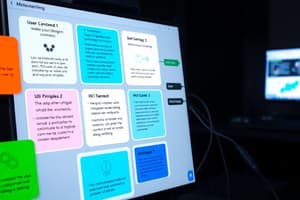Podcast
Questions and Answers
What is the likely topic of Lecture 5?
What is the likely topic of Lecture 5?
- Introduction to Human Computer Interaction (correct)
- Advanced Topics in Human Computer Interaction
- The Future of Human Computer Interaction
- The History of Human Computer Interaction
How many slides were there in Lecture 5?
How many slides were there in Lecture 5?
- 5
- 7
- 6
- 3 (correct)
What is the content of the slide marked 'End of Chapter'?
What is the content of the slide marked 'End of Chapter'?
- An image or a diagram that illustrates the chapter content
- A brief overview of the next chapter
- A list of questions for further discussion
- A summary of the chapter's key points (correct)
What is the likely purpose of the slides marked '1'?
What is the likely purpose of the slides marked '1'?
What is the likely purpose of the slide marked 'Class Assignment 1'?
What is the likely purpose of the slide marked 'Class Assignment 1'?
Flashcards
Human Computer Interaction (HCI)
Human Computer Interaction (HCI)
The study of how people interact with computers and software.
CSBP 316
CSBP 316
A course code for Human Computer Interaction at UAE University.
Lecture 5
Lecture 5
Specific lecture in a series focusing on HCI concepts.
Class Assignment 1
Class Assignment 1
Signup and view all the flashcards
Study Notes
Human Computer Interaction (HCI) - CSBP 316
- Course: Human Computer Interaction (HCI), CSBP 316
- Institution: CIT, UAE University
- Lecture: Introduction to HCI, Lecture 5
UCD: A Simple Interaction Design Lifecycle Model
- Discovering Requirements: Initial step in understanding user needs and goals.
- Designing Alternatives: Generating multiple design options for the product/service.
- Prototyping: Creating interactive representations of the designs.
- Evaluating: Testing prototypes with users.
- Final Product: The final, improved product incorporating feedback and adjustments.
- Iterative Process: These steps are cyclical—feedback from evaluation informs adjustments and redesigns.
UCD: Another Lifecycle Model (Google Design Sprint)
- Phases: Unpack, Sketch, Decide, Prototype, Test, Iterate, Decide.
- Unpack: Understanding the problem and initial ideas.
- Sketch: Generating different design options.
- Decide: Refining design choices.
- Prototype: Creating tangible representations.
- Test: Evaluating with target users.
- Iterate: Revise the design based on feedback.
- Decide: Finalizing design decisions.
Good Design Is Not...
- Applying Checklists and Guidelines Only: UCD is a more holistic approach that emphasizes understanding of the people involved.
- Using Oneself as the Model User: Real users exhibit diverse needs and abilities, so including real user testing in the design process is important.
- Common Sense Alone: Design solutions should be tested and verified with real users by an expert, especially in areas like safety or accessibility.
- Designing without Expert Advice: Specialists in areas like human factors can play an important role in identifying and implementing user needs effectively and safely.
- Ignoring Context and Needs: Designs should be crafted within a specific context for the user, and in consideration of unique needs and challenges.
Class Assignment 1
- This is a class assignment for the course.
Studying That Suits You
Use AI to generate personalized quizzes and flashcards to suit your learning preferences.




